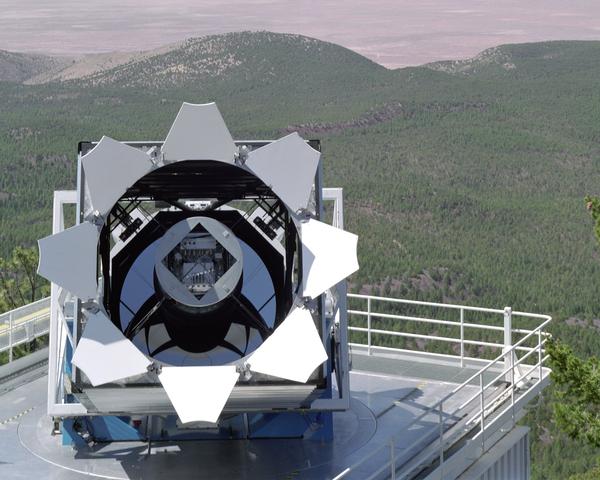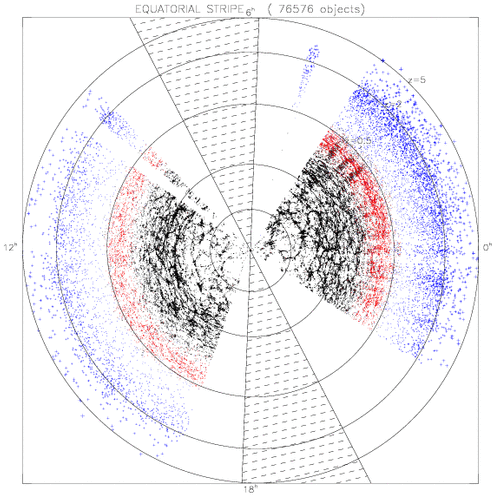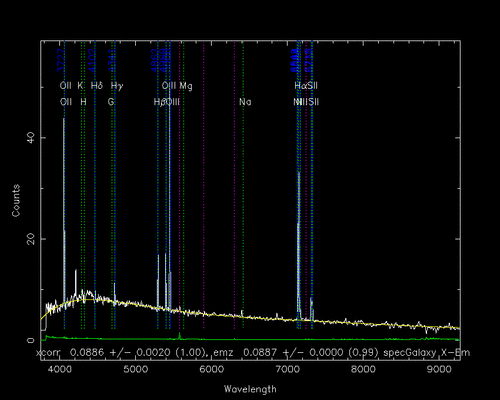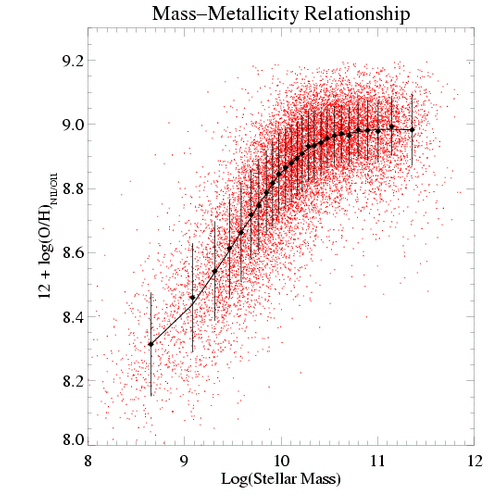Studying Galaxies in the Sloan Digital Sky Survey |
|
The Max-Planck-Institute for Astrophysics (MPA) is one of three German astronomical institutes involved in the Sloan Digital Sky Survey (SDSS). The SDSS is the most ambitious astronomical survey project ever undertaken. The survey telescope is located at Apache Point Observatory in Sunspot, New Mexico. The multi-purpose 3.5 meter telescope (Fig. 1) boasts several innovative features, including remote control, rapid instrument change capability, light-weight construction and unique sky-monitoring capabilities.

|
| Figure 1: The SDSS survey telescope stands out against the breathtaking backdrop of the Sacramento mountains. |
The Sloan Digital Sky Survey will map in detail one-quarter of the entire sky, determining the positions and absolute brightnesses of over 100 million celestial objects. It will also measure the distances to more than a million galaxies and quasars. This will provide a 3-dimensional map of the Universe through a volume about a hundred times bigger than the volume explored so far (Fig. 2). This map will reveal how big the largest structures in the Universe really are and what they look like. It will help us understand how galaxies like our own Milky Way formed out of the sea of tiny density fluctuations that existed just after the Big Bang.

|
| Figure 2: A "slice" through the 3-dimensional distribution of galaxies and quasars. The observer on Earth is located at the centre of the circle. The distance from the centre of the circle represents the logarithm of the redshift of the galaxy. The positions of 76,576 objects (less than 10% of the final survey) are plotted in this diagram. Black points represent galaxies from the main spectroscopic survey, red points are galaxies from the Luminous Red Galaxy survey and blue points are quasars. |
The MPA joined the SDSS collaboration in early 2001 as an associate partner. A group of astronomers at the MPA are currently devoting considerable effort to analyzing the spectra of galaxies obtained as part of the survey. To find distances to celestial objects, SDSS astronomers must go back to each detected galaxy and observe it once again with an instrument called a spectrograph -- basically a giant prism that separates light into its component colours. The spectrograph analyzes how much light of each colour comes from the object. Since the Universe is expanding, the wavelength of all light coming from the galaxy has been stretched as it traveled. This stretching is called the redshift of the light. By measuring the redshift of each galaxy, astronomers can determine the distance to the galaxy and thus create 3-dimensional maps. An example of a typical galaxy spectrum is shown in Fig. 3.

|
| Figure 3: The spectrum of a typical emission-line galaxy in the SDSS survey. |
The spectrum is not smooth, but contains many spiky features, caused by the absorption or the emission of light by atoms of particular elements, such as hydrogen, oxygen, nitrogen, sulphur etc. By studying the detailed features in a galaxy spectrum, astronomers not only measure the distance to the object, but also learn a great deal about the physical conditions in the galaxy, such as the ages and total mass of its stars, the rate at which new stars are being formed, the amount of metals that have been produced by supernovae over its lifetime, and the amount of starlight that has been absorbed by dust in dense molecular clouds.

|
| Figure 4: The metallicities of galaxies are plotted as a function their stellar masses for approximately 20,000 emission-line galaxies in the SDSS survey. A metallicity corresponding to the solar value has a value 12+log(O/H)=8.8 on the y-axis. |
Fig. 4 shows some first results obtained in a collaboration between C. Tremonti and T. Heckman of Johns Hopkins University, Baltimore, and G. Kauffmann and S. Charlot at MPA. Stellar masses and metallicities were calculated for a sample of 20,000 emission-line galaxies in the SDSS. The results show that the metallicities of galaxies are highly correlated with their masses below a stellar mass of 1010 solar masses. The correlation of metallicity with mass was found to be considerably tighter than the corresponding correlation with optical luminosity previously documented in the literature. At stellar masses greater than 1010 solar masses, the mass-metallicity relation flattens at a value close to solar. This ``turnover'' has long been a prediction of classic galactic wind models. In these models, the fraction of metals ejected by galaxies in supernova-driven winds is inversely proportional to the potential well depth of the galaxy. At a certain limiting mass, galaxies are no longer able to eject metals, and the galaxy is effectively a ``closed box'' system. The metallicity is then predicted to be equal to the yield of heavy elements produced by unit mass of stars. This is around the solar value for a standard stellar initial mass function. The discovery of the typical mass scale below which galaxies have been able to eject a substantial fraction of their metals, and perhaps their interstellar medium, has important implications for understanding a whole host of astrophysical phenomena, including the star formation histories of galaxies and the chemical enrichment of the intergalactic medium as a function of cosmic epoch.
Guinevere Kauffmann
Further information:
| MPA-Home |